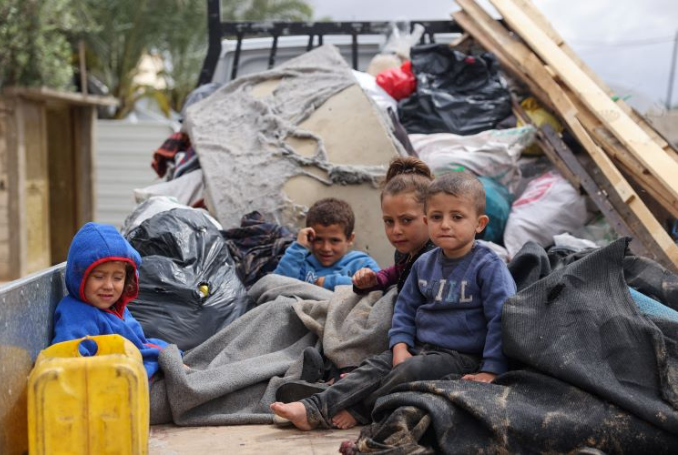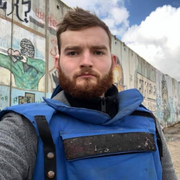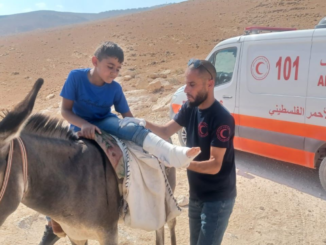
Having failed to achieve any of its declared military goals after the invasion of Gaza City and later Khan Yunis, the Israeli leadership set its sights on the last remaining area of the besieged coastal territory.
Despite urging civilians to flee the rest of the Gaza Strip to the southernmost city of Rafah, the area has now become the primary target of Tel Aviv’s ground offensive.
Now framed by the Israeli military and much of Western media, as the last remaining stronghold of Hamas, Rafah was previously labeled a safe haven for the civilian population of Gaza.
‘Real Hamas Headquarters’
After initially having claimed that Hamas was operating a multi-layered military headquarters underneath al-Shifa Hospital in northern Gaza, the pretext for Israel’s invasion of the medical complex, they quickly pivoted to claiming that Khan Yunis was “the real Hamas headquarters”.
Following the collapse of Israel’s lies regarding the alleged headquarters for Hamas under al-Shifa, in December of 2023 the city of Khan Yunis was invaded under a similar pretext. Predictably, there was no “Hamas headquarters” located in Khan Yunis and its primary hospital, the Nasser Hospital, which they attempted to claim was a base for military operations like they claimed al-Shifa Hospital was.
Then, after imposing a comprehensive siege on the people who were trapped in the city of Khan Yunis in early January, the focus again shifted further south. In a speech delivered by Israeli Prime Minister, Benjamin Netanyahu, in mid-January, he spoke about the alleged Hamas supply line and presence in the city of Rafah.
KAN: The World Central Kitchen organization announced the suspension of its activities in Rafah after the Israeli operation in the area.
UNICEF: There is no safety or aid for the children of Gaza.
FOLLOW OUR LIVE BLOG https://t.co/hwgsvEw1nB pic.twitter.com/8TcvQU3vJ9
— The Palestine Chronicle (@PalestineChron) May 29, 2024
Elaborating on what he claimed was ongoing smuggling of weapons to Hamas across the Egyptian border, a charge vehemently denied by Cairo, he asserted that “we will not end the war until we close this breach,” making clear his intentions to invade Rafah.
In late January, the threat of invading Rafah started to cause a real stir due to protests from the Egyptian authorities. Cairo’s 1979 Camp David agreement which normalized ties between Egypt and Israel, stipulated that there must be a demilitarized zone in what is known as the Philadelphia or Salahudeen Route.
On paper the invasion of the corridor along the Egyptian border nullifies the normalization agreement, meaning that Cairo would be justified in declaring a defensive war and breaking ties with Tel Aviv formally.
‘Credible Plan’
By February, following criticism of the Israelis by their Western allies and statements urging them not to invade Rafah, the US Biden administration urged the Israeli government to formulate a “credible plan” to protect civilians in the area before invading.
This came amidst a sea of reports indicating the impending catastrophe in Rafah, due to some 1.4 million civilians having gathered there in order to seek refuge after being displaced from their homes, most of them living in tents and crudely formed shelters.
Israel, later that same month, declared their intention to invade Rafah during the Muslim Holy Month of Ramadan, after the UN had said that it would be a “humanitarian nightmare with untold regional consequences”.
Without actually putting together a credible ceasefire/prisoner-swap deal, Israeli war cabinet member, Benny Gantz, threatened that the Ramadan invasion would go ahead if the Israeli prisoners were not released from Gaza.
This came at a time when PM Netanyahu was talking about “finishing the job in Rafah”, stemming from his provably false claims that Hamas had been defeated elsewhere.
In mid-March, after countless threats to invade Rafah, Israel declared that it had approved a plan to attack the southern Gaza city.
At this time, Benjamin Netanyahu was said to be violating US President Joe Biden’s “red line”, which he claimed was the invasion of Rafah.
Calling Israel’s Bluff
This alleged “red line” was then altered many times, mainly due to false reports in the US media surrounding what the Biden administration’s policy actually was. An MSNBC interview conducted with the US President at the start of March didn’t help with public perception either, as it was noted that Biden contradicted himself a number of times during the same conversation.
By the end of March, Israel then asserted that it would invade Rafah during May at the latest and began amassing forces along the Karem Abu Salem (Kerem Shalom) crossing area.
On May 6, following the sudden announcement by Hamas that they had accepted the US-Israeli ceasefire proposal, with minor amendments, it effectively called Israel’s bluff. During the week prior, Netanyahu had been publicly declaring his intention to invade Rafah instead of concluding a ceasefire and prisoner exchange deal.
Israel rejected the ceasefire proposal that was paraded around by US Secretary of State, Antony Blinken, as a generous and strong deal, deciding instead to invade Eastern Rafah that same day.
Israel’s 401st Brigade was sent to capture the Rafah Crossing between Egypt and Gaza, while its Givati Brigade moved into areas in eastern Rafah.
Despite the months of threats, the fear of Egypt’s reaction to the violation of the Camp David agreement, and warnings from the UN and human rights groups about the humanitarian catastrophe that an invasion would cause, Israel went ahead with invading anyway.
Egypt, which just lost a soldier after an exchange of fire along the border, has not taken any action in self-defense and despite the issuance of an additional provisional ruling by the International Court of Justice (ICJ) ordering Israel to end its invasion of Rafah, Israel continues to push forward.
The Egyptian regime has accepted the Israelis violating the Camp David agreement and the murder of one of their soldiers, even attempting to hide this event from their own people.
The US continues to supply Israel with the arms it needs to invade Rafah and still can’t decide on its alleged “red line” and what that looks like.
Both the US and Egyptian governments are now being proven to be liars who remain complicit in Israel’s assault on Rafah.
(The Palestine Chronicle)

– Robert Inlakesh is a journalist, writer, and documentary filmmaker. He focuses on the Middle East, specializing in Palestine. He contributed this article to The Palestine Chronicle.







